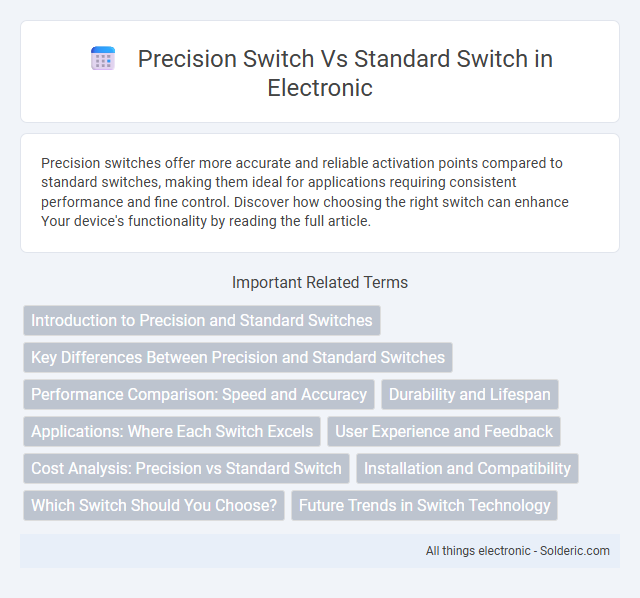Precision switches offer more accurate and reliable activation points compared to standard switches, making them ideal for applications requiring consistent performance and fine control. Discover how choosing the right switch can enhance Your device's functionality by reading the full article.
Comparison Table
| Feature | Precision Switch | Standard Switch |
|---|---|---|
| Accuracy | High - Designed for exact positioning | Moderate - Suitable for general use |
| Response Time | Fast - Immediate and reliable actuation | Variable - Slower in some models |
| Durability | Robust - Built for frequent precise operations | Standard - Suitable for less demanding environments |
| Application | Industrial automation, robotics, measurement devices | Consumer electronics, general machinery |
| Cost | Higher - Due to enhanced design and materials | Lower - Mass-produced, basic functionality |
| Switch Type | Micro switches, limit switches with fine tolerances | Toggle, rocker, basic push-button switches |
Introduction to Precision and Standard Switches
Precision switches offer finely tuned actuation with high repeatability and sensitivity, making them ideal for applications requiring exact control and consistent performance. Standard switches provide reliable on/off functionality suitable for general use, but lack the heightened accuracy and durability found in precision models. Choosing between these switches depends on the need for precision, with precision switches favored in instrumentation, medical devices, and aerospace industries where exact measurements are critical.
Key Differences Between Precision and Standard Switches
Precision switches offer higher accuracy, repeatability, and lower contact resistance compared to standard switches, making them ideal for applications demanding exact control and minimal signal loss. Standard switches typically prioritize cost-effectiveness and durability for general-purpose use, but may lack the consistent performance seen in precision models. Your choice between these switches depends on the specific requirements for sensitivity, reliability, and operational environment in your project.
Performance Comparison: Speed and Accuracy
Precision switches offer superior speed and accuracy compared to standard switches, delivering rapid response times critical for high-performance applications. Their engineered mechanisms minimize debounce delay and enhance actuation precision, ensuring consistent input detection. Your experience will benefit from increased reliability and smoother operation, especially in demanding environments requiring exact control.
Durability and Lifespan
Precision switches are engineered with higher-quality materials and tighter manufacturing tolerances, resulting in superior durability and a longer operational lifespan compared to standard switches. They can endure millions of actuations without significant performance degradation, making them ideal for applications requiring consistent reliability under heavy use. Standard switches typically have shorter lifespans due to less robust components, leading to more frequent replacements in high-demand environments.
Applications: Where Each Switch Excels
Precision switches excel in applications requiring high accuracy and repeatability, such as aerospace instrumentation, medical devices, and robotics, where exact actuation is critical. Standard switches perform well in general-purpose uses like consumer electronics, household appliances, and automotive controls, where cost efficiency and durability are prioritized. The choice depends on the necessity for precise control versus broader, less sensitive switching functions.
User Experience and Feedback
Precision switches deliver more accurate tactile feedback and consistent actuation force, enhancing user control and satisfaction compared to standard switches. Users report improved typing speed and reduced finger fatigue with precision switches due to their optimized actuation points and smoother responsiveness. Feedback from gamers and professionals highlights the reliability and improved precision that directly impact performance and comfort.
Cost Analysis: Precision vs Standard Switch
Precision switches typically incur higher upfront costs compared to standard switches due to advanced sensor technology and improved accuracy. However, the long-term cost benefits of precision switches include reduced maintenance expenses and minimized operational downtime. Standard switches may offer lower initial investment but often lead to higher replacement and calibration costs over time.
Installation and Compatibility
Precision switches offer straightforward installation compatible with a wide range of industrial systems due to their standardized mounting and wiring configurations. Standard switches may require additional adapters or modifications to fit certain applications, potentially increasing installation time and complexity. Your choice will impact system integration efficiency and long-term maintenance ease.
Which Switch Should You Choose?
Choosing between a precision switch and a standard switch depends on the specific requirements of your application. Precision switches offer higher accuracy, reliability, and longer lifespan due to their finely tuned mechanisms, making them ideal for sensitive electronics and industrial controls. For general use where cost-efficiency and durability under less stringent conditions are sufficient, standard switches provide a practical and affordable option.
Future Trends in Switch Technology
Future trends in switch technology emphasize increased precision switches for enhanced responsiveness and reliability in industrial automation and consumer electronics. Advanced materials like graphene and innovations in micro-electromechanical systems (MEMS) are driving the development of switches with faster activation times and greater durability compared to standard mechanical switches. Integration of AI-driven calibration and adaptive feedback mechanisms is expected to further optimize switch performance in precision applications.
precision switch vs standard switch Infographic

 solderic.com
solderic.com